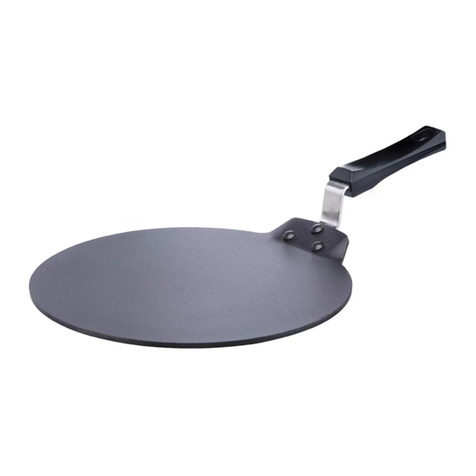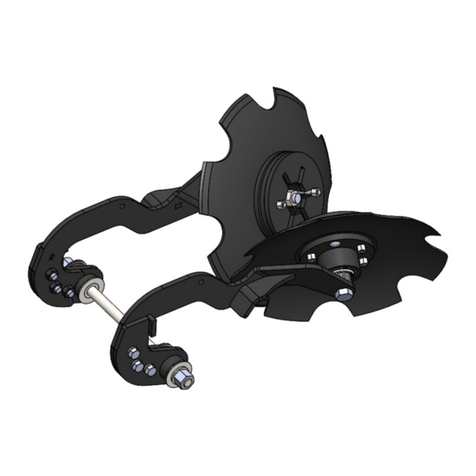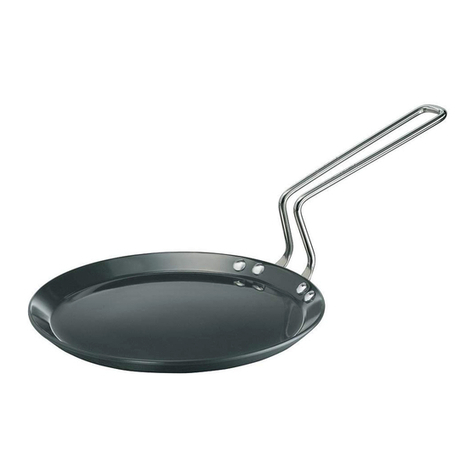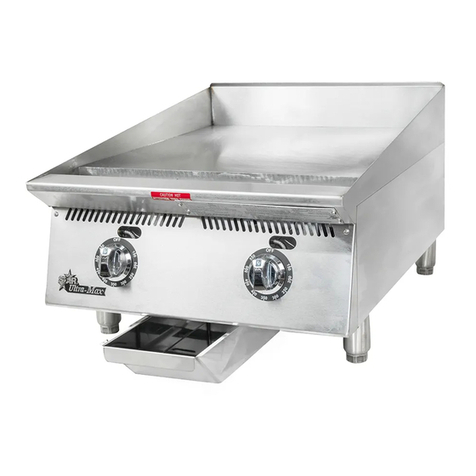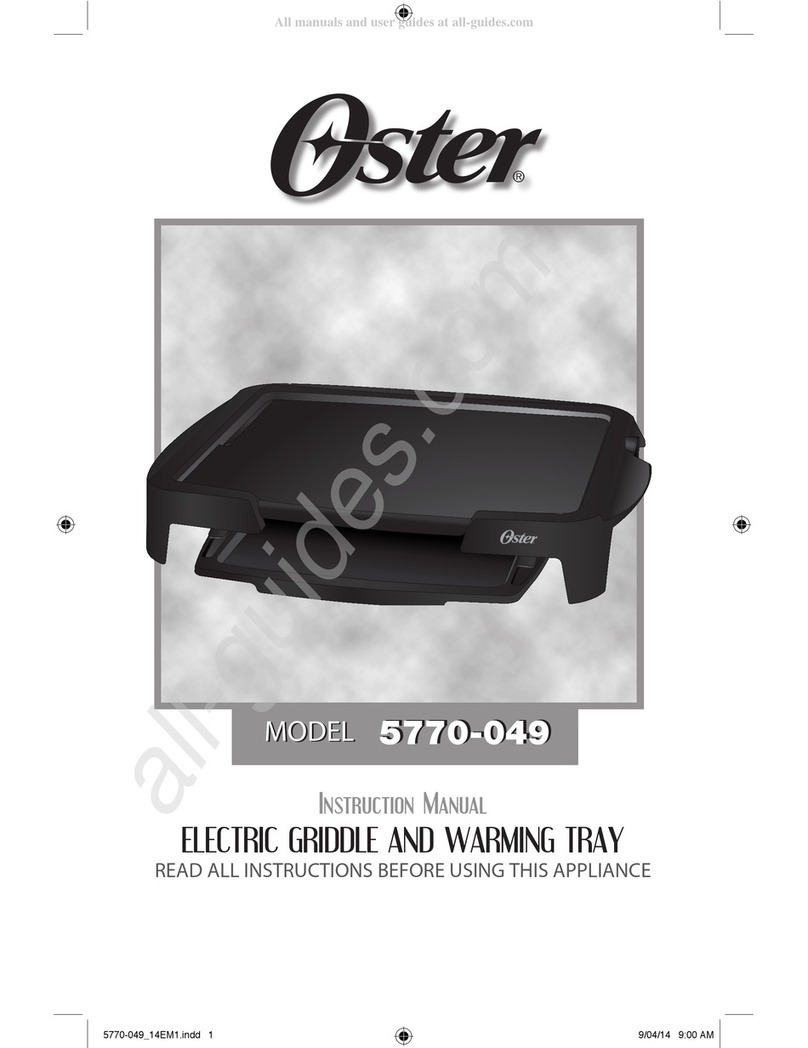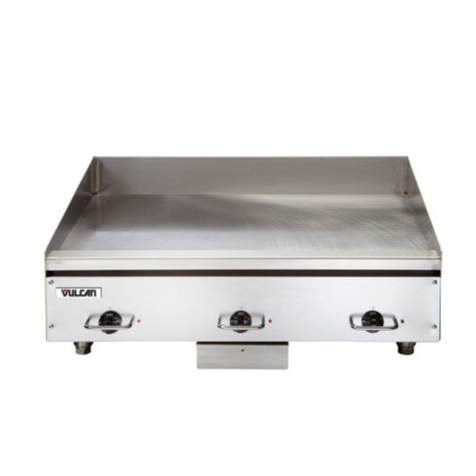Hawkins Futura Nonstick Tava Griddle User manual


IMPORTANT SAFEGUARDS
1. Do not use high heat.
2. Do not use on chulha, industrial burners or any heat source
which cannot be regulated to low and medium heat or whose
flame spreads beyond the tava.
3. Limit preheating of tava without food on medium heat to no
more than 3 minutes for the 22 cm tava, 4 minutes for the 26 cm
tava and 5 minutes for the 30 cm tava.
4. When tava is hot, ensure that it is never without food.
5. Do not cut on tava or scrape it with metal or sharp edged objects.
6. Clean thoroughly after each use in hot water with a mild soap
or detergent and a dishcloth or sponge. Do not use abrasive
cleaning agents or scrubbers.
7. Do not put hot tava in cold water.
8. Do not wash tava in a dishwasher.
9. Do not put tava in a hot oven or under a broiler.
10. The handle of tava should be parallel to the kitchen counter
– not sticking out.
11. Always give careful attention to a hot tava, hot oil and flame/
heat.
12. Do not leave frying unattended. In case oil or butter should ever
catch fire, have a metal lid handy to cover the tava. Never pour
water on the fire as this may spread the fire.
13. Do not drop food or other objects from a height on the tava
particularly when it has hot oil or butter. Place food gently on
the tava to avoid spattering.
14. Read and follow instructions in this Manual.
IF YOU HAVE ANY QUESTIONS, COMMENTS
OR SUGGESTIONS OR IF YOU NEED ANY
HELP WITH THIS PRODUCT OR WITH ANY OF
OUR OTHER PRODUCTS, PLEASE CONTACT
THE CONSUMER SERVICE MANAGER AT:
Hawkins Cookers Limited
P O BOX 6481, MUMBAI 400 016, INDIA
TEL (91 22) 2444 0807 FAX (91 22) 2444 9152
EMAIL [email protected]
®

Hawkins Cookers Limited is the proprietor of the trademarks 'Hawkins' and 'Futura' in India and in various other countries throughout the world. Product design registered in India.
2009 Copyright reserved. All Rights Reserved. Edited and published by Neil Vasudeva on behalf of Hawkins Cookers Limited, Maker Tower F 101, Cuffe Parade, Mumbai 400 005, India
and printed in 2009 at Rite-Print-Pak, Senapati Bapat Marg, Lower Parel, Mumbai 400 013.
Introduction
Futura Nonstick Cookware
Futura Nonstick Cookware is made with a patented process by
which high quality nonstick coating is fixed on to a hard anodised
surface which makes it most durable. Futura Nonstick Cookware comes
in many useful shapes and sizes to suit your different cooking needs.
All are made from heavy gauge, pure, virgin aluminium for fast and
even heat conduction. The pans are well-balanced with sturdy,
stay-cool handles. The bottom and outer sides are hard anodised to
give you a surface that will not tarnish, pit or corrode and will stay
looking new for years.
Futura Nonstick Flat Tava (Griddle)
This Manual contains instructions and 10 recipes for all the
Futura Nonstick Flat Tava (Griddle): 22 cm diameter, 26 cm diameter
with stainless steel handle, 26 cm diameter with plastic handle and
30 cm diameter. The size of the tava is stamped on the underside of the
tava. Your tava will give you years of easy, great-tasting, healthful,
economical cooking and easy clean-up if you carefully follow the
instructions in this Manual.
The recipes in this Manual are written for the 30 cm Futura
Nonstick Flat Tava. If you have a tava of 22 cm diameter or 26 cm
diameter, you will need to make adjustments given in the chart
Adapting Recipes to Different Sizes of the Flat Tava (Griddle)
on pages 8 and 9.
Contents
Page
Important Safeguards inside front cover
Introduction 1
How to Use 2
How to Clean 4
Easy Tips for Better Cooking 5
How to Cook Paratha 6
Measurements 7
Adapting Recipes to Different Sizes
of the Flat Tava (Griddle) 8
Recipes
Alu Paratha (Unleavened Bread Stuffed
with Potatoes) 10
Alu Tikki (Potato Cutlets – Sindhi Style) 11
Coconut Chutney 11
Dosa (Rice and Gram Pancakes) 12
French Toast 12
Fried Eggs 13
Paratha (Layered Unleavened Bread) 13
Phulka (Puffed Unleavened Bread) 14
Rawa Dosa (Semolina and Gram Pancakes) 14
Uttapam (Savoury Rice and Gram Pancakes) 15
English/Hindi Translations 15
Glossary (Meanings and Methods) 16
1

How to Use
Before Use
Remove sticker/label. Remove any adhesive with baby or vegetable
oil. Before using tava for the first time, wash in hot water with a mild
soap or detergent, rinse in clear water and dry. Do not wash in a
dishwasher.
Before putting your tava on the heat, assemble and prepare all
ingredients and keep spatula, utensils, serving plate etc. ready in the
cooking area. If you are looking for things once the tava is on the
heat, it can overheat quickly and destroy the nonstick coating.
Seasoning
It is not necessary to season the tava. If, however, you plan to cook
food which tends to stick such as fried eggs without any oil or
butter for the first use or before you have cooked with oil on the tava,
seasoning will assist release of the food. To season: rub 1 tsp/5 ml
vegetable oil over the clean nonstick surface using a paper napkin or
clean cotton cloth. Wipe off oil with a paper napkin or clean cotton
cloth. Wash and dry tava.
Suitable Heat Sources
High temperatures will shorten the life of the nonstick and may
destroy it. Use tava only on domestic gas, electric or halogen stoves
in which the temperature can be regulated to low and medium heat.
Use a burner to suit the size of your tava ––
––
– gas flames should not spread
beyond the tava. Do not use high heat. Use low to medium heat.
Limit Preheating of Tava
Some foods/recipes require preheating of the tava. Foods such as
dosa, French toast, paratha, phulka and uttapam require the tava to be
at a certain temperature before you cook the first batch.
When preheating a cold empty tava before beginning to
cook, it is critical that THE HEAT IS NO MORE THAN MEDIUM
and the time is strictly limited to no more than the following:
Even if you have a small quantity of oil or butter or ghee
(1 tablespoon/15 ml or less) on the tava, you should observe the limits
given in the table above. Overheating can occur quickly if tava is left on
the heat without food so NEVER keep tava empty on the heat once it
is hot.
Avoid Overheating: Check Your Burner
If food is smoking or burning, reduce heat. Using medium or lower
heat and limiting the time the empty tava is heating are the basic
techniques to avoid overheating.
The tava can overheat even on medium heat if the burner is
providing excessive heat. To check if your burner can overheat even
on medium heat, do the following test.
Step 1. Place clean tava on medium heat. Heat tava for the minutes
given in the following chart:
2
Tava Heat for:
22 cm 1 minute
26 cm 2 minutes
30 cm 3 minutes
Tava Maximum Preheating Time
22 cm 3 minutes
26 cm 4 minutes
30 cm 5 minutes

Avoid Scratching, Damage, Breakage
Use wooden, heat-resistant nylon, plastic or rubber spatula/utensils.
Metal utensils will scratch and reduce the life of the nonstick coating.
Do not cut or scrape with metal objects or knives. If using a metal
spatula, try to keep spatula parallel to tava to avoid digging into the
coating. Try to touch the food and minimise contact with the coating.
Do not leave plastic, nylon or rubber utensils on tava while it is hot.
Do not hit tava or bang its rim. Do not bang tava down on pan
supports. Lift tava from the pan supports – do not drag it across the
pan supports. When storing tava ensure that the nonstick coating is
not gouged or rubbed against any hard or sharp surface. Do not stack
other utensils on the coating without protecting it. Plastic handles are
liable to break under a sharp or forceful blow.
After use, faint scratches or marks may appear on the nonstick
coating. These are marks of normal wear and tear and do not affect the
performance of the coating. Even if some of the coating is scraped off,
the tava is still safe to use. The coating is non-toxic and inert; if
accidentally and unknowingly ingested, it passes through the body
harmlessly.
Saving Energy
The instructions given in this Manual for regulating heat in order to
protect your tava and produce tasty food will also optimise fuel
consumption.
Step 2. Press one finger firmly into whole wheat flour (atta). Do not
pinch. Flick from a distance of about 21/2inches/6 cm a small, fine,
even dusting of flour on centre of tava and immediately begin
counting off seconds (''one second, two second, three second'' etc.)
while watching the flour. The time the flour takes to become dark
brown gives a rough indication of how hot the tava is. As long as
flour has not turned dark brown within 15 seconds, the tava is not
overheated.
Step 3. Follow the steps in the chart below to complete the test.
3
Flour turns
dark brown in
15 seconds or
less? Tava is… Action needed
A. Yes Overheated 1. Remove tava from heat at
once.
2. Reduce heat setting.
3. Try from Step 1 again
when tava has cooled.
B. No Not 1. Continue heating tava.
overheated Repeat flour test at
1 minute intervals. If flour
turns dark brown in
15 seconds or less, tava
is overheated: follow
action as per A.
2. If flour does not turn dark
brown in 15 seconds or
less, stop test when
recommended Maximum
Preheating Time for tava is
reached. The heat setting
is all right for preheating.

How to Clean
Wash After Every Use
Taking care to protect your hand from the hot tava with sufficient
paper or cloth, wipe off residual oil with a paper napkin or muslin
cloth from hot tava immediately after cooking. Doing so makes
cleaning very much easier.
Always wash all surfaces of tava thoroughly after every use in hot
water with a mild soap or detergent and a dishcloth or sponge. Do
not wash tava in a dishwasher. Let tava cool before immersing in water.
For stubborn spots on the nonstick surface, soak tava in hot water
about 10 minutes and rub with a non-abrasive plastic scrubber – never
use steel wool, coarse or metallic scouring pads or abrasive detergents.
When cleaning the tava ensure that the nonstick coating is not
gouged or rubbed against any hard or sharp surface. While cleaning,
keep a folded kitchen cloth or a piece of any other soft material
such as rubber or sponge underneath the tava to avoid damaging
the tava.
Wash wooden spatula in hot water with a mild soap or detergent,
rinse and dry immediately – do not soak.
Metallic marks – most often from gas stove pan supports – may
appear on the hard anodised base. To remove metallic marks from
base: apply a kitchen cleanser, such as 'Vim', to the marks and rub
with an abrasive kitchen scrubber, such as 'Scotch-Brite' or fine
steel wool.
Avoid ''Baked-On'' Food/Stains
If tava is not cleaned thoroughly, a thin layer of food or grease
may remain. When the tava is heated next, this food/grease becomes
''baked-on'' and very difficult to remove. ''Baked-on'' food and the
stains from ''baked-on'' food may be impossible to remove without
damaging the tava.
If you get ''baked-on'' food/stains, you may try the following
methods (knowing that the tava surface may get damaged):
On the Hard Anodised (Bottom Surface): Make a thick paste of
a cleaning powder such as 'Vim' and apply it to the ''baked-on''
food/stain. Wait 5 to 10 minutes. Scour with steel wool using a
circular motion. Wash.
On the Nonstick (Top/Cooking Surface): Make a thick paste of
a cleaning powder such as 'Vim' and apply it to the ''baked-on''
food/stain. Wait 5 to 10 minutes. Scour with a plastic scrubber using
a circular motion. Wash.
4

Easy Tips for Better Cooking
1. Read the entire recipe before beginning to work. Assemble and
prepare all ingredients. Follow recipe step-by-step.
2. Information on weights and measures is on page 7.
3. Unless otherwise noted, in the recipes:
•All foods are to be appropriately cleaned and washed.
•Onions and potatoes are to be peeled.
4. For Users Outside India: In the recipes, size descriptions of
ingredients refer to food available in India. Outside India, follow the
weights rather than the size descriptions.
5. All Hindi words used in the recipes are translated to English on
page 15 and/or explained in the Glossary (Meanings and Methods).
If you come across a word you do not know, check Glossary page 16.
6. Time and heat settings in the recipes refer to the large burner of
an efficient domestic gas stove. You may have to adjust these times
and settings to suit your stove. For best cooking results, adjust the heat
so that cooking times are the same as those given in the recipes or
in the chart on pages 8 and 9 –whichever is appropriate for the size of
tava. You will be helped in making these adjustments by the steps and
indications given in various recipes (for example,
a few light brown
specks should appear on the underside of a paratha after 1 minute
on medium heat). Avoid high temperatures for the best cooking results,
conserving fuel and preserving the life of the nonstick coating.
7. The nonstick coating of the tava retards browning somewhat in
certain foods. For browner results, try cooking slightly longer. Do not
use high heat.
8. Adding a little oil or butter to the tava may enhance the colour,
taste and texture of many foods.
9. Do not heat oil till it smokes. It damages the oil and will burn the food.
10. It may be easier to turn some foods with two spatulas rather than
one.
11. The quantities of green chillies recommended in the recipes are
calculated to produce food of moderate pungency. You may increase,
reduce or eliminate the chillies according to your taste.
12. Eggs require controlled heat or they may become tough. Eggs
should be cooked on low to medium temperatures. Higher heat
hardens the protein, resulting in rubbery eggs.
13. Eggs, batters, doughs and fillings should be at room temperature
before beginning to cook.
14. To prevent sticking when rolling out rounds of dough: slightly
flatten balls and press the balls/coils lightly in flour on both sides.
Shake off excess flour and roll out.
15. While cooking on tava, paratha and phulka leave a residue of
flour that will burn. Using a kitchen cloth wipe off accumulated residue
after every third roti.
5

6
How to Cook Paratha
THESE INSTRUCTIONS ARE TO BE USED AS INDICATED IN CERTAIN RECIPES.
1. Put round on preheated tava. Cook 1 minute. Top should begin to
look dry and darken. (There should be a few light brown specks on
the underside.)
2. Turn over with a wooden spatula. (If you can adjust the heat so
that a few light brown specks appear on the underside in 1 minute,
you will be cooking at the ideal temperature.)
3. Spread 1/2tsp
/
2.5 ml ghee all over top surface of round.
4. Turn over. Spread 1/2tsp
/
2.5 ml ghee in the same way.
5. Turn over. Lightly press entire round with spatula, rotating and
pressing a small area at a time. (Pressing paratha ensures even cooking.
If you notice a lighter area, press on the opposite side of that area
when you have turned over paratha.)
6. Turn over. Press in the same way and spread 1/2tsp
/
2.5 ml ghee
over round.
7. Turn over. Continue pressing and turning till paratha is evenly
browned (medium-brown) on both sides. (Paratha and stuffed paratha
take about 5 minutes to cook.)
8. For instructions on how to stuff paratha: see recipe on page 10.

7
The quantities of ingredients in the recipes are given in two measuring systems – U.S. and metric – separated by this mark ''
/
''.
Use any one of the measurements.
Measurements
Volume
All measurements are level, not heaped.
Measurement Equivalent
1 teaspoon 5 ml
1/2tablespoon 11/2teaspoons
/
7.5 ml
1 tablespoon 3 teaspoons
/
15 ml
1/4cup 4 tablespoons
/
60 ml
1/3cup 5 tablespoons +
1 teaspoon
/
80 ml
1/2cup 8 tablespoons
/
120 ml
3/4cup 12 tablespoons
/
180 ml
1 cup 16 tablespoons
/
240 ml
1 litre 1000 ml
Weight
Metric Equivalent
28 g (rounded off to 30 g) 1 oz
450 g 16 oz
/
1 lb
1 kg 2.2 lb
Length
Measurement Equivalent
1/4inch 6 mm
1/2inch 1.3 cm
3/4inch 1.9 cm
1 inch 2.5 cm
Abbreviations
Abbreviation Equivalent Abbreviation Equivalent Abbreviation Equivalent
tsp teaspoon oz ounce mm millimetre
tbsp tablespoon lb pound cm centimetre
ml millilitre g gram

The recipes in this Manual are written for the 30 cm Futura Nonstick Flat Tava. The 22 cm tava and the 26 cm tava both heat faster than the
30 cm tava at the same level of heat. For best cooking results, adjust heat so that cooking times are the same as those given in the recipes unless
otherwise noted in the following chart. When using the 22 cm tava or the 26 cm tava, follow the recipes except as noted herein below:
Recipe Page Required Changes
No. 22 cm Flat Tava 26 cm Flat Tava
Alu Paratha 10 Step 9: Heat tava on medium heat no more than 3 minutes.
Alu Tikki 11 Step 2: Heat 1 tsp
/
5 ml oil on tava on medium heat no
more than 3 minutes. Step 3: First three batches:
Add 4 patties. Fry till underside is golden brown (about
3 minutes). Dribble 1/2tsp
/
2.5 ml oil all over patties. Turn
over. Fry till underside is golden brown (about 4 minutes).
Step 4: Remaining batch: 1/2tsp
/
2.5 ml oil on tava;
2 patties; 1/4tsp
/
1.3 ml oil all over patties.
Coconut Chutney 11 Ingredients may be reduced as required. Cooking groundnuts in a single layer recommended.
Dosa 12 Step 5: Heat tava on medium heat no more than 3 minutes.
Step 6: Stir batter and pour 3 tbsp
/
45 ml in centre of
tava. Make a round about 71/4inch
/
18 cm in diameter.
Add 1/4tsp
/
1.3 ml oil around edges and all over dosa.
Cook first side about 11/2minutes. Follow all other
instructions in this step.
French Toast 12 Step 2: Each batch is 1 slice. Step 3: Heat tava on
medium heat about 2 minutes and reduce heat to low.
Spread 1/2tsp
/
2.5 ml butter on tava where slice will
be placed.
Fried Eggs 13 Reduce ingredients by one-half; cook 2 eggs at a time.
Step 2: Heat tava on medium heat about 2 minutes.
Paratha 13 Step 7: Heat tava on medium heat no more than 3 minutes.
Adapting Recipes to Different Sizes of the Flat Tava (Griddle)
8
Step 9: Heat tava on medium heat no more than 4 minutes.
Step 2: Heat 21/2tsp
/
12.5 ml oil on tava on medium heat
no more than 4 minutes. Step 3: First two batches:
Add 6 patties. Step 4: Remaining batch: 1 tsp
/
5 ml oil on
tava; 2 patties.
Step 5: Heat tava on medium heat no more than 4 minutes.
Step 6: Stir batter and pour 3 tbsp
/
45 ml in centre of
tava. Make a round about 71/2inch
/
19 cm in diameter.
Add 1/4tsp
/
1.3 ml oil around edges of dosa. Dribble
1/4tsp
/
1.3 ml oil all over dosa. Follow all other
instructions in this step.
Step 2: First two batches are 3 slices each.
Step 3: Heat tava on medium heat about 3 minutes.
Spread 11/2tsp
/
7.5 ml butter on tava where slices will be
placed. Step 5: Remaining batch: 1 tsp
/
5 ml butter; 2 slices.
Step 2: Heat tava on medium heat about 3 minutes.
Step 7: Heat tava on medium heat no more than 4 minutes.

Recipe Page Required Changes
No. 22 cm Flat Tava 26 cm Flat Tava
Phulka 14 Step 4: Heat tava on medium heat no more than 3 minutes.
Rawa Dosa 14 Step 3: Heat tava on medium heat no more than 3 minutes.
Step 4: Stir batter and pour 3 tbsp
/
45 ml in centre of
tava. Make a round about 71/4inch
/
18 cm in diameter.
Add 1/4tsp
/
1.3 ml butter around edges and all over dosa.
Cook first side about 11/2minutes. Follow all other
instructions in this step.
Uttapam 15 Step 6: Heat tava on medium heat no more than 3 minutes.
Step 7: Before pouring batter, reduce heat slightly. Stir
batter and pour 1/2cup
/
120 ml in centre of tava. Make a
round about 61/2inch
/
16 cm in diameter. Dribble 3/4tsp
/
3.8 ml oil all over uttapam. Follow all other instructions in
this step.
Adapting Recipes to Different Sizes of the Flat Tava (Griddle) (continued)
Step 4: Heat tava on medium heat no more than 4 minutes.
Step 3: Heat tava on medium heat no more than 4 minutes.
Step 4: Stir batter and pour 3 tbsp
/
45 ml in centre of
tava. Make a round about 71/2inch
/
19 cm in diameter.
Add 1/4tsp
/
1.3 ml butter around edges of dosa. Dribble
1/4tsp
/
1.3 ml butter all over dosa. Follow all other
instructions in this step.
Step 6: Heat tava on medium heat no more than 4 minutes.
9

Alu Paratha (Unleavened Bread Stuffed with
Potatoes)
Yield: 12 paratha
Filling
5 large (1lb 11 oz
/
760 g) potatoes 'boiled' (see page 16),
peeled and mashed while still
hot; allow to cool
2 medium (81/2oz
/
240 g) onions finely chopped
2green chillies finely chopped
2 tbsp
/
30 ml coriander leaves chopped
1 tbsp
/
15 ml salt
13/4tsp
/
8.8 ml cumin seeds
1/2tsp
/
2.5 ml red chilli powder
11/2tsp
/
7.5 ml coriander powder
a pinch pepper
11/4tbsp
/
19 ml pomegranate seeds crushed
Dough
41/2cups (1 lb
/
450 g) sifted wheat flour
3/4tsp
/
3.8 ml salt
2 tbsp
/
30 ml ghee
11/2cups
/
360 ml water
Ghee for Frying
1/4cup + 2 tbsp
/
90 ml
1. To make filling: Mix all Filling ingredients.
2. Rub hands with a little ghee. Make 12 balls about 13/4inch
/
4.5 cm in diameter. Keep covered.
3. To make dough: Mix flour, salt, ghee and 1 cup
/
240 ml water.
Add enough of remaining water (1/2cup
/
120 ml), 2 tbsp
/
30 ml at a
time, mixing after each addition, till dough forms a soft ball (stop
adding water before dough becomes wet and sticky). Knead till dough
is smooth and elastic (about 2 minutes). Keep covered with a damp
cloth about 30 minutes.
4. Rub
hands with a little ghee. Knead dough briefly. Make 12 balls
about 11/2inch
/
3.8 cm in diameter. Keep covered with a damp cloth.
5. On a floured board, roll each ball of dough into a flat round
43/4inch
/
12 cm in diameter (see page 5 para 14). Keep on a lightly
floured surface, covered with a damp cloth.
6. To stuff paratha: Place round on palm of hand. Cup hand slightly
to form a depression in centre of round (Figure A). Put a ball of
filling on round (Figure B). Surround filling evenly with dough by
gently opening and closing hand slightly in a pulsating motion till
some edges just meet. Pinch together the edges which meet just
enough to seal (Figure C). Pat sealed area to get an even thickness of
dough. Repeat till round is closed fully.
7. Place stuffed round on board. Flatten slightly. Stuff and place
remaining rounds of dough in the same way as given in step 6. Keep
covered with a damp cloth.
8. On a floured board, roll each stuffed ball gently into a flat round
71/4inch
/
18 cm in diameter. Keep on a lightly floured surface, covered
with a damp cloth.
9. Heat tava on medium heat no more than 5 minutes (for preheating
tava other than 30 cm, see chart on page 8).
10. Put round on tava. Cook as explained on page 6. Cook remaining
rounds in the same way. Serve hot, accompanied with curd. •
Figure A Figure B Figure C
10

Alu Tikki (Potato Cutlets – Sindhi Style)
Yield: 14 tikki
5 slices bread
(each 31/2inch x 31/2inch x 3/8inch
/
9 cm x 9 cm x 1 cm)
1 cup
/
240 ml water
5 large (1 lb 11 oz
/
760 g) potatoes 'boiled' (see page 16),
peeled and mashed while still hot
3green chillies finely chopped
21/2tbsp
/
37.5 ml coriander leaves finely chopped
13/4tbsp
/
26.3 ml mint leaves finely chopped
13/4tsp
/
8.8 ml salt
3/4tsp
/
3.8 ml red chilli powder
11/4tsp
/
6.3 ml cumin seeds
2 tbsp
/
30 ml vegetable oil
1. Immerse each bread slice in water for 15 seconds. Squeeze out
and discard water. Break bread into tiny pieces. Mix bread and all
other ingredients except oil. Make 14 patties about 23/4inch
/
7 cm
in diameter, 1/2inch
/
1.3 cm thick.
2. Heat 1 tbsp
/
15 ml oil on tava on medium heat no more than
5 minutes (for tava other than 30 cm, see chart on page 8). Spread oil
on tava with wooden spatula all over the area where the patties will be
placed.
3. Add 7 patties. Fry on both sides till golden brown (about 5 minutes
on each side). Remove.
4. Spread remaining oil (1 tbsp
/
15 ml) on tava. Fry remaining patties
in the same way as in step 3. Serve hot, accompanied with chutney or
tomato ketchup. •
Coconut Chutney
Yield: 2 cups
1/2cup (2
2/3oz
/
80 g) groundnuts
2 cups (5
2/3oz
/
160 g) coconut grated
2/3cup
/
160 g curd beaten
6green chillies
2 tsp
/
10 ml salt
1 tsp
/
5 ml sugar
1/4cup
/
60 ml water
Tempering
1 tbsp
/
15 ml vegetable oil
1 tsp
/
5 ml mustard seeds
1 tsp
/
5 ml urad dal
12 small curry leaves
1. Put groundnuts on tava on medium heat. Stir constantly till
groundnuts start crackling (about 5 minutes). Remove from tava.
Allow to cool. Remove skins by rubbing groundnuts.
2. Grind into a paste groundnuts, coconut, curd, chillies, salt and
sugar, gradually adding water.
3. Tempering: Heat oil in a small pan on medium heat about
1 minute. Add mustard seeds. When crackling, add urad dal. Stir a few
seconds. Add curry leaves. Stir constantly till dal is light golden brown.
Immediately pour over chutney. Mix. Serve with Dosa,Rawa Dosa and
Uttapam (for recipes, see pages 12, 14 and 15).•
11

Dosa (Rice and Gram Pancakes)
Yield: 15 dosa
1/2cup (31/2oz
/
100 g) rice
1 cup (7 oz
/
200 g) parboiled rice
1/2cup (31/2oz
/
100 g) urad dal
21/2cups
/
600 ml water other than for step 1
2 tsp
/
10 ml salt
1/4cup + 1 tbsp
/
75 ml vegetable oil
1. In a bowl, cover rice, parboiled rice and urad dal with water at least
1 inch
/
2.5 cm above ingredients. Soak 4 hours. Drain.
2. Grind rice-dal mixture into a paste gradually adding 2 cups
/
480 ml
water.
3. In a large bowl, mix rice-dal paste and salt. Cover and keep aside
(not in a refrigerator) at least 12 hours to ferment.
4. Mix fermented paste and enough of remaining water (1/2cup
/
120 ml) to make a thin batter.
5. Heat tava on medium heat no more than 5 minutes (for preheating
tava other than 30 cm, see chart on page 8).
6. Stir batter and pour 1/4cup
/
60 ml
in centre of tava. Quickly place
the back of a rounded ladle very lightly on batter. Using a continuous
circular motion in one direction, gently spread batter evenly outwards
from centre to make a round about 91/2inch
/
24 cm in diameter. Add
1/2tsp
/
2.5 ml oil around edges of dosa. Dribble 1/2tsp
/
2.5 ml oil all
over dosa. Cook about 2 minutes. With a spatula, press edges of dosa
gently, if needed. Turn over. With a spatula, press edges of dosa
gently, if needed. Cook 1 minute. Remove. Cook remaining dosa in
the same way. Serve hot, accompanied with Coconut Chutney
(for
recipe, see page 11). •
French Toast
Yield: 8 toasts
3eggs
3/4cup + 3 tbsp
/
225 ml milk
11/2tbsp
/
22.5 ml sugar
3 drops vanilla essence (optional)
1/4tsp
/
1.3 ml salt
8 slices bread
(each about 31/2inch x 31/2inch x
3/8inch
/
9 cm x 9 cm x 1 cm)
1 tbsp + 1 tsp
/
20 ml butter
1. In a bowl, beat eggs just till yolks and whites are mixed. Add milk,
sugar, vanilla essence and salt. Mix.
2. Turn 1 slice bread in egg mixture leaving each side in mixture
about 20 seconds. Remove with a spatula and put on a plate. Turn and
remove 3 more slices in the same way.
3. Heat tava on medium heat about 4 minutes (for preheating tava
other than 30 cm, see chart on page 8). Spread 2 tsp
/
10 ml butter on
tava all over the area where the slices will be placed.
4. Add the 4 soaked slices. Pour egg mixture leftover on the plate
back into the bowl. Fry on both sides till browned (2-3 minutes on
each side). Remove. (While slices are frying turn 4 more slices in egg
mixture as described in step 2 and keep aside.)
5. Spread 2 tsp
/
10 ml butter on tava. Fry the soaked slices in the same
way as in step 4. Adjust heat to medium-low*if tava is too hot for the
second batch. Serve hot with honey or jam.
*A heat setting between medium and low. •
12

Fried Eggs
Yield: 4 eggs
4eggs
1 tbsp
/
15 ml butter
a large pinch salt
a large pinch pepper
1. Break 2 eggs on a saucer. Repeat with another saucer.
2. Heat tava on medium heat about 4 minutes (for preheating tava
other than 30 cm, see chart on page 8). Add butter and spread on tava
with wooden spatula. Slide eggs onto tava. Cook about 1 minute or to
desired doneness. Sprinkle salt and pepper. Serve hot. •
Paratha (Layered Unleavened Bread)
Yield: 12 paratha
6 cups (1 lb 5 oz
/
600 g) sifted wheat flour
11/4tsp
/
6.3 ml salt (optional)
2cups + 4 tsp
/
500 ml water
1/2cup
/
120 ml ghee
1. Mix flour, salt and 11/2cups
/
360 ml water. Add enough of
remaining water (1/2cup + 4 tsp
/
140 ml), 2 tbsp
/
30 ml at a time,
mixing after each addition, till dough forms a soft ball (stop adding
water before dough becomes wet and sticky). Knead till dough is
smooth and elastic (about 2 minutes). Keep covered with a damp cloth
about 30 minutes.
2. Rub
hands with a little ghee. Knead dough briefly. Make
12 balls about 13/4inch
/
4.5 cm in diameter. Keep covered with a damp
cloth.
3. On a floured board, roll a ball of dough into a flat round 71/4inch
/
18 cm in diameter (see page 5 para 14). Spread 1/2tsp
/
2.5 ml ghee all
over the top surface of the round.
4. Starting at one edge, tightly roll up round (Figure A). With palms of
both hands roll back and forth till extended to 91/2inch
/
24 cm long
(Figure B). Wind around one end into a flat coil (Figure C). Put free end
over centre top of coil (Figure D). Press down free end gently. Flatten
coil slightly.
5. Make remaining balls into coils in the same way as given in
step 3 and step 4. Keep covered with a damp cloth.
6. On a floured board, roll each coil into a flat round 71/4inch
/
18 cm
in diameter. Keep on a lightly floured surface, covered with a damp
cloth.
7. Heat tava on medium heat no more than 5 minutes (for preheating
tava other than 30 cm, see chart on page 8).
8. Put round on tava. Cook as explained on page 6.
9. Remove paratha from tava. With paper napkins or cloth protecting
both hands, cup hands around paratha and quickly bring together
(crushing paratha) and release. Rotate paratha 90 degrees. Repeat
crushing. Cook remaining rounds in the same way. Serve hot. •
13
Figure A Figure B
Figure C Figure D

Rawa Dosa (Semolina and Gram Pancakes)
Yield: 20 dosa
3/4cup (51/3oz
/
150 g) urad dal soaked for 2 hours
and drained
3 cups + 2 tbsp
/
750 ml water
2 cups (10
2/3oz
/
300 g) rawa
2 tsp
/
10 ml salt
1/3cup + 4 tsp
/
90 g butter melted
1. Grind urad dal
into a paste gradually adding 11/4cups
/
300 ml
water.
2. Put rawa in a large bowl. Gradually add remaining water (13/4cups
+ 2 tbsp
/
450 ml), stirring constantly to make a smooth batter. Add
dal paste and salt. Mix. Cover and keep aside (not in a refrigerator) at
least 12 hours to ferment.
3. Heat tava on medium heat no more than 5 minutes (for preheating
tava other than 30 cm, see chart on page 9).
4. Stir batter and pour 1/4cup
/
60 ml in centre of tava. Quickly place
the back of a rounded ladle very lightly on batter. Using a continuous
circular motion in one direction, gently spread batter evenly outwards
from centre to make a round about 91/2inch
/
24 cm in diameter. Add
1/2tsp
/
2.5 ml butter around edges of dosa. Dribble 1/2tsp
/
2.5 ml
butter all over dosa. Cook about 2 minutes. With a spatula, press
edges of dosa gently, if needed. Turn over. With a spatula, press edges
of dosa gently, if needed. Cook 1 minute. Remove. Cook remaining
dosa in the same way. Serve hot, accompanied with Coconut Chutney
(for recipe, see page 11). •
14
Phulka (Puffed Unleavened Bread)
Yield: 12 phulka
4 cups (14 oz
/
400 g) sifted wheat flour
3/4tsp
/
3.8 ml salt
(optional)
11/4cups
/
300 ml water
1. Mix flour, salt and 1 cup
/
240 ml water. Add enough of remaining
water (1/4cup
/
60 ml), 2 tbsp
/
30 ml at a time, mixing after each addition,
till dough forms a soft ball (stop adding water before dough becomes
wet and sticky). Knead till dough is smooth and elastic (about
2 minutes). Keep covered with a damp cloth about 30 minutes.
2. With oiled hands, knead dough briefly. Make 12 balls about
13/4inch
/
4.5 cm in diameter. Keep covered with a damp cloth.
3. On a floured board, roll each ball of dough into a flat round
71/4inch
/
18 cm in diameter (see page 5 para 14). Keep on a lightly
floured surface, covered with a damp cloth.
4. Heat tava on medium heat no more than 5 minutes (for preheating
tava other than 30 cm, see chart on page 9). Put round on tava.
Cook till small blisters appear on surface and very few light brown
specks appear on underside (about 50 seconds). Turn over. Cook till
brown specks appear on underside (about 30 seconds). Turn over. If
you are experienced with the technique, you may puff up phulka
directly on the flame. Otherwise, with a folded kitchen cloth, press
edges of phulka till phulka puffs up and/or underside has brown specks
(about 1 minute). Cook remaining rounds in the same way.
Serve hot. •

Uttapam (Savoury Rice and Gram Pancakes)
Yield: 6 uttapam
11/2cups (10
2/3oz
/
300 g) rice
3/4cup (51/3oz
/
150 g) urad dal
1 cup + 2 tbsp
/
270 ml water other than for step 1
1 tbsp
/
15 ml salt
1 large (61/3oz
/
180 g) onion
finely chopped
4green chillies
chopped
2 tbsp
/
30 ml coriander leaves chopped
3 tbsp
/
45 ml vegetable oil
1. In separate bowls, cover rice and urad dal with water at least
1 inch
/
2.5 cm above ingredients. Soak 4 hours. Drain.
2. Grind rice into a paste, gradually adding 1/2cup
/
120 ml water.
3. Grind dal into a paste, gradually adding remaining water (1/2cup
+ 2 tbsp
/
150 ml).
4. In a large bowl, mix rice and dal pastes and salt to make batter.
Cover and keep aside (not in a refrigerator) at least 12 hours to ferment.
5. Mix fermented batter and all other ingredients except oil.
6. Heat tava on medium heat no more than 5 minutes (for preheating
tava other than 30 cm, see chart on page 9).
7. Stir batter and pour 3/4cup
/
180 ml in centre of tava. With the back
of a rounded ladle, quickly and gently spread batter to make a round
of even thickness about 71/4inch
/
18 cm in diameter. Add 1/2tsp
/
2.5 ml oil around edges of uttapam. Fry till surface appears dull and
underside is golden brown (about 3 minutes). Dribble 1 tsp
/
5 ml oil
all over uttapam. Turn over. Fry till underside is golden brown (about
3 minutes). Remove. Fry remaining uttapam in the same way. Serve hot,
accompanied with Coconut Chutney
(for recipe, see page 11). •
English/Hindi Translations
Bread Dabalroti
Butter Makkhan
Coconut Nariyal
Coriander leaves Hara dhania ke patte
Coriander powder Pissa sukha dhania
Cumin seeds Jeera
Curd; Yogurt Dahi
Curry leaves Kadi patta/Meethi neem ke patte
Green chillies Hari mirch
Groundnuts Moongphalli ke dane
Mint leaves Pudina
Mustard seeds Rai
Pepper Pissi kali mirch
Pomegranate seeds Anardana
Rawa; Sooji Semolina
Red chilli powder Pissi lal mirch
Urad dal Split skinned black gram
15

Glossary (Meanings and Methods)
Grate (Kasna):To reduce food to fine particles by rubbing it against
the surface of a grater (an abrasive implement with sharp-edged, raised
perforations).
Knead:
To work dough with hands by pushing into the dough, folding
it over and pushing again until dough is resilient, smooth and satiny.
Parboiled rice (Usna chawal): Unpolished rice which has been
partially boiled, then dried and dehusked.
Patty: A small oval or round flattened cake of chopped or minced
food.
Rawa:Semolina – grainy, pale-yellow meal derived from hard wheat.
Roti:A general term for Indian unleavened breads.
Sift:
To pass dry ingredients through a sieve.
Wheat flour (Gehun ka atta):
Flour made from whole wheat (usually
a variety low in gluten), very finely ground for making Indian bread.
Outside India, this flour is called 'chapatti flour' and is available in East
Indian food stores. A fairly close substitute is whole wheat pastry flour.
Regular whole wheat flour gives heavier roti and is stiffer and more
difficult to work with than 'chapatti flour'. If regular whole wheat flour
must be used, sift it several times through a very fine sieve (to get a fine
flour and to remove bran) and substitute refined flour for half the
whole wheat flour in a recipe. Once adept at handling the dough, you
may decrease the quantity of refined flour to suit your taste.
Batter: A mixture made from flour and a liquid such as water, milk or
egg which is thin enough to pour or drop from a spoon.
Beat:
To mix with an instrument such as a spoon, whisk or electric
beater using a regular, rapid, rhythmic movement.
'Boiled' Potatoes cooked in a Hawkins Pressure Cooker:
Size of the Potato Water Pressure
(Whole, Unpeeled) Quantity Cooking
Time
(Small – 75 g) 1 cup 6 minutes
(Medium – 100 g) 1 cup 10 minutes
(Large – 150 g) 11/2cups 15 minutes
Method: Pour water in cooker. Put grid in cooker. Place potatoes on
grid. Close cooker. Bring to full pressure (first whistle) on high heat.
Reduce heat to medium and cook the required time. Remove cooker
from heat. Release pressure by slight lifting of vent weight. Open
cooker.
Dough:
A mixture of flour and a liquid such as milk or water which is
stiff enough to knead or roll.
Floured board:
A flat smooth piece of rigid material (such as wood or
marble) used for rolling or shaping the dough, also known as chackla,
dusted lightly with flour to prevent dough sticking.
Ghee:
Clarified butter.
16
Other manuals for Futura Nonstick Tava Griddle
1
Table of contents
Other Hawkins Griddle manuals
Popular Griddle manuals by other brands
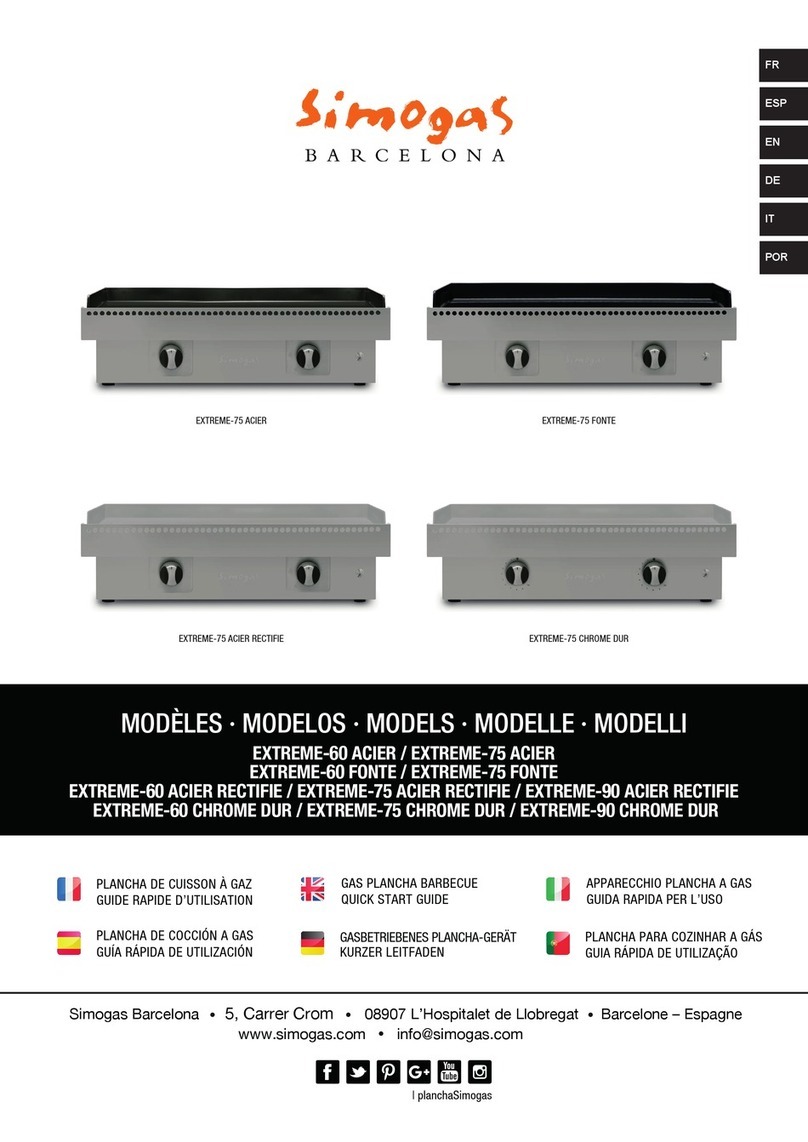
Simogas
Simogas EXTREME Series quick start guide

Royal Catering
Royal Catering RCPKG-3600-R user manual
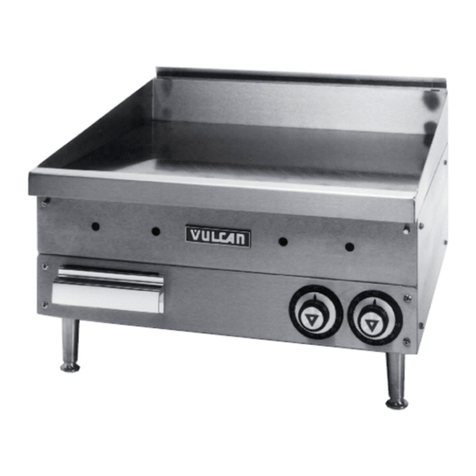
Vulcan-Hart
Vulcan-Hart MGG24 Installation & operation manual
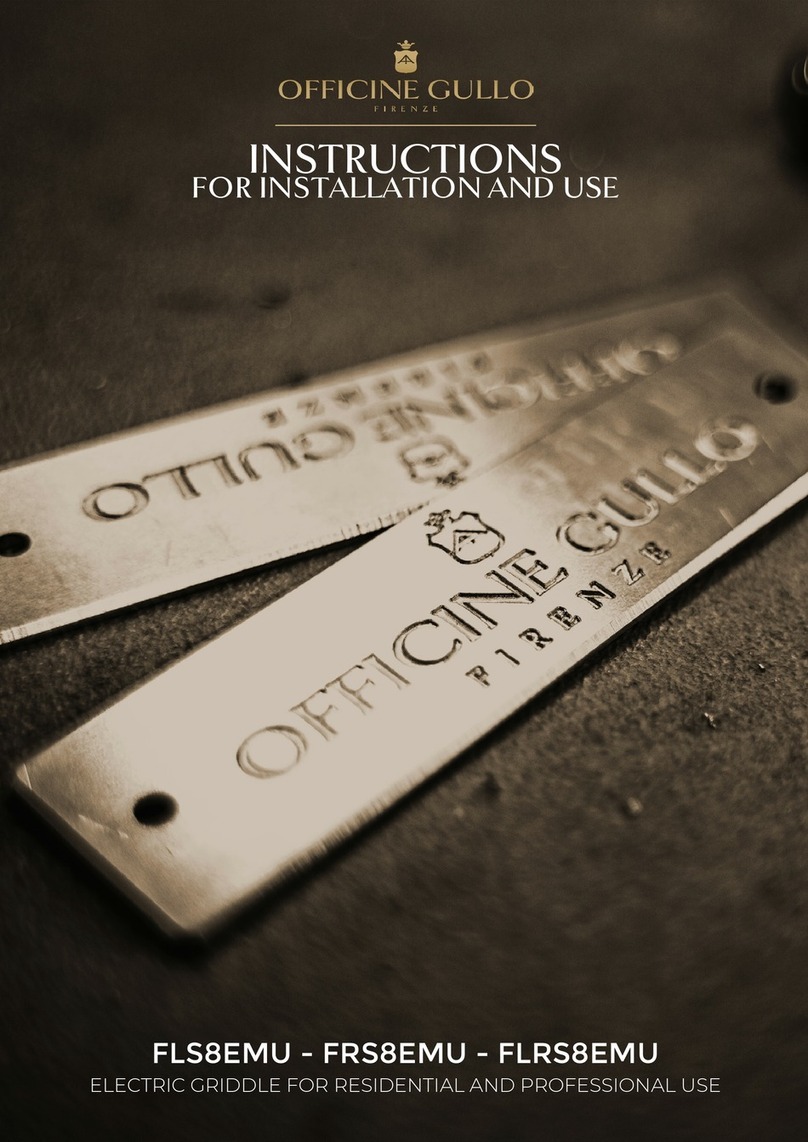
Officine Gullo
Officine Gullo FLS8EMU Instructions for installation and use
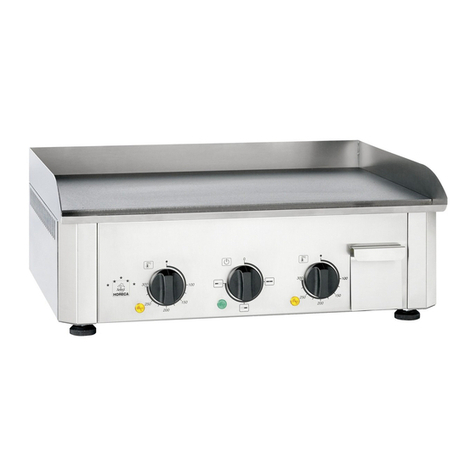
Horeca Select
Horeca Select GEG 2001 instruction manual

Woodson
Woodson WGDA50 Installation & operation manual
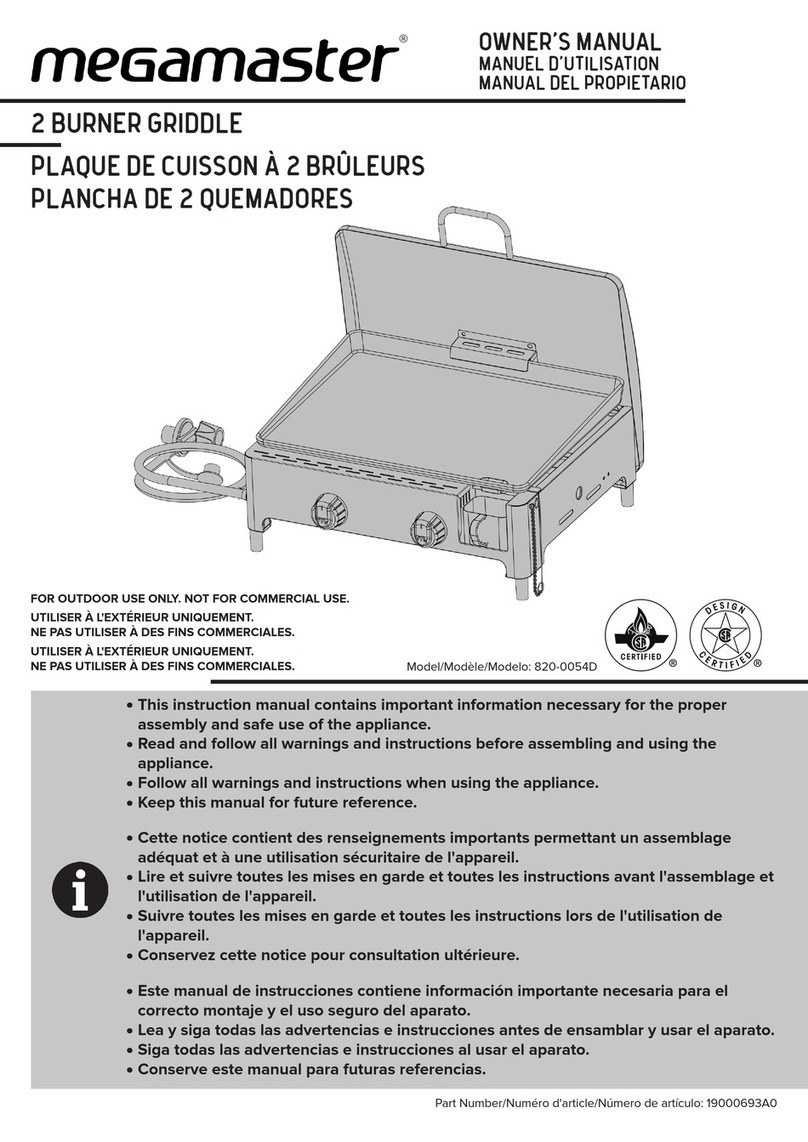
Megamaster
Megamaster 820-0054D owner's manual
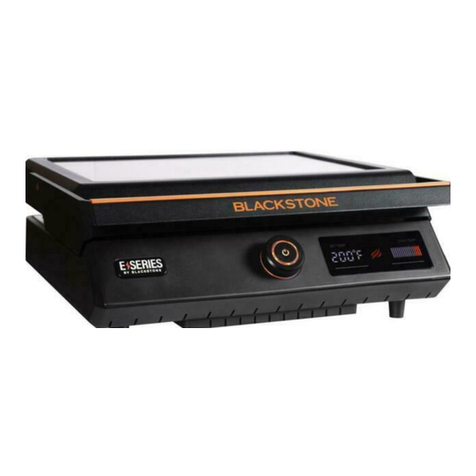
Black Stone
Black Stone E Series 8000 owner's manual
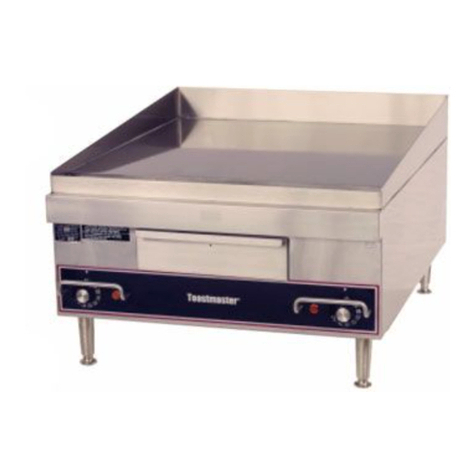
Toastmaster
Toastmaster TECG7324 brochure

Star
Star 615M Installation and operating instructions

Lang
Lang 160TT Installation, operation, maintenance, & troubleshooting

Black Stone
Black Stone 5011 Assembly instructions


